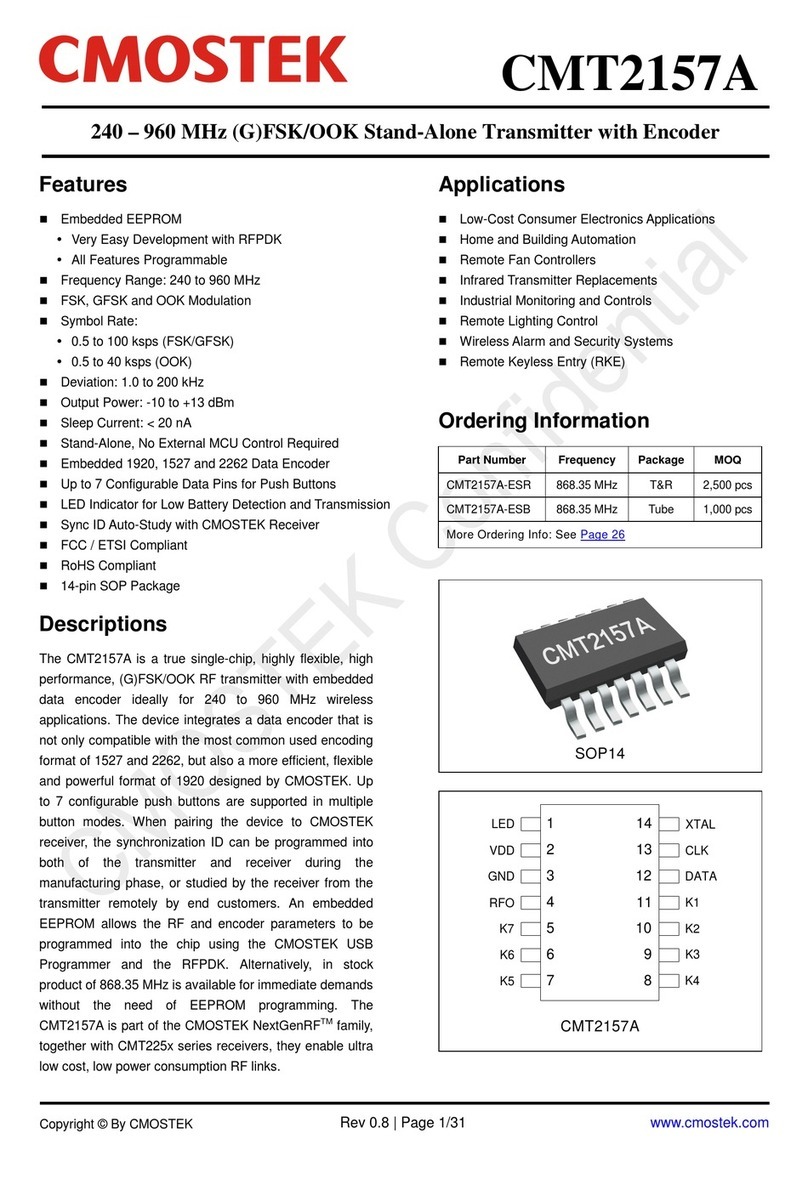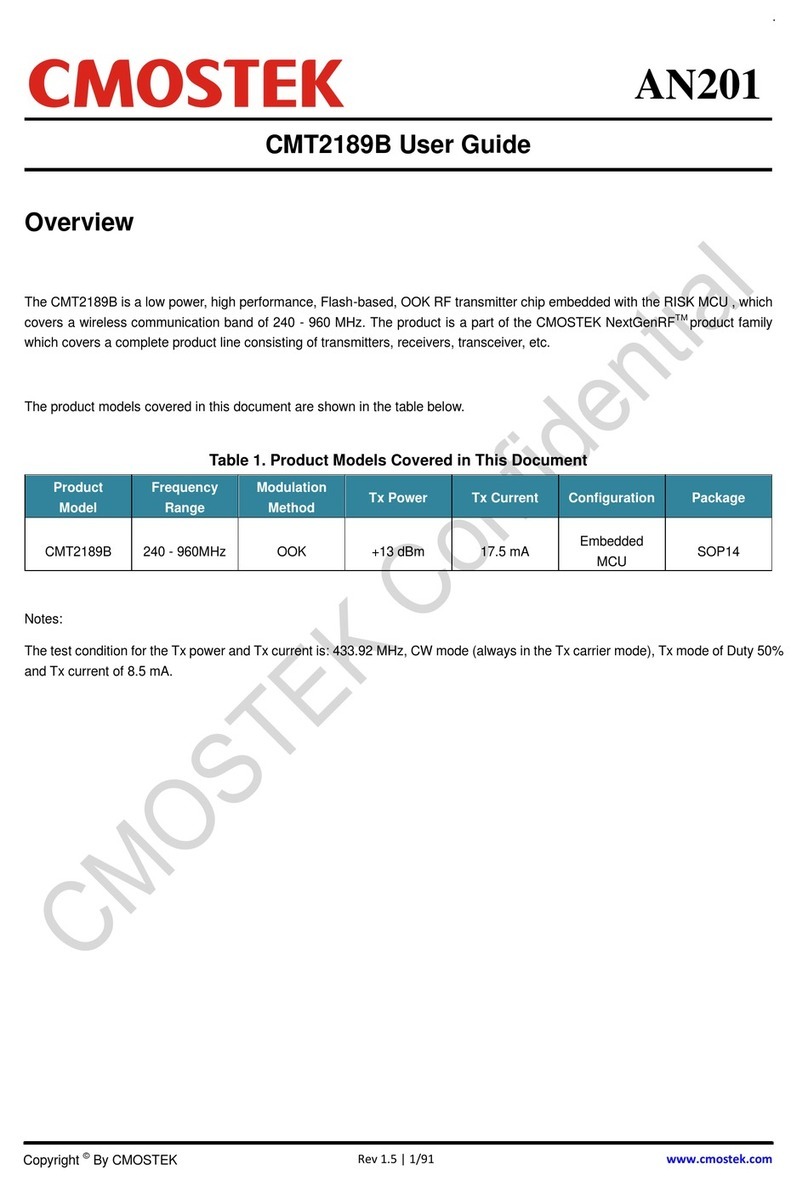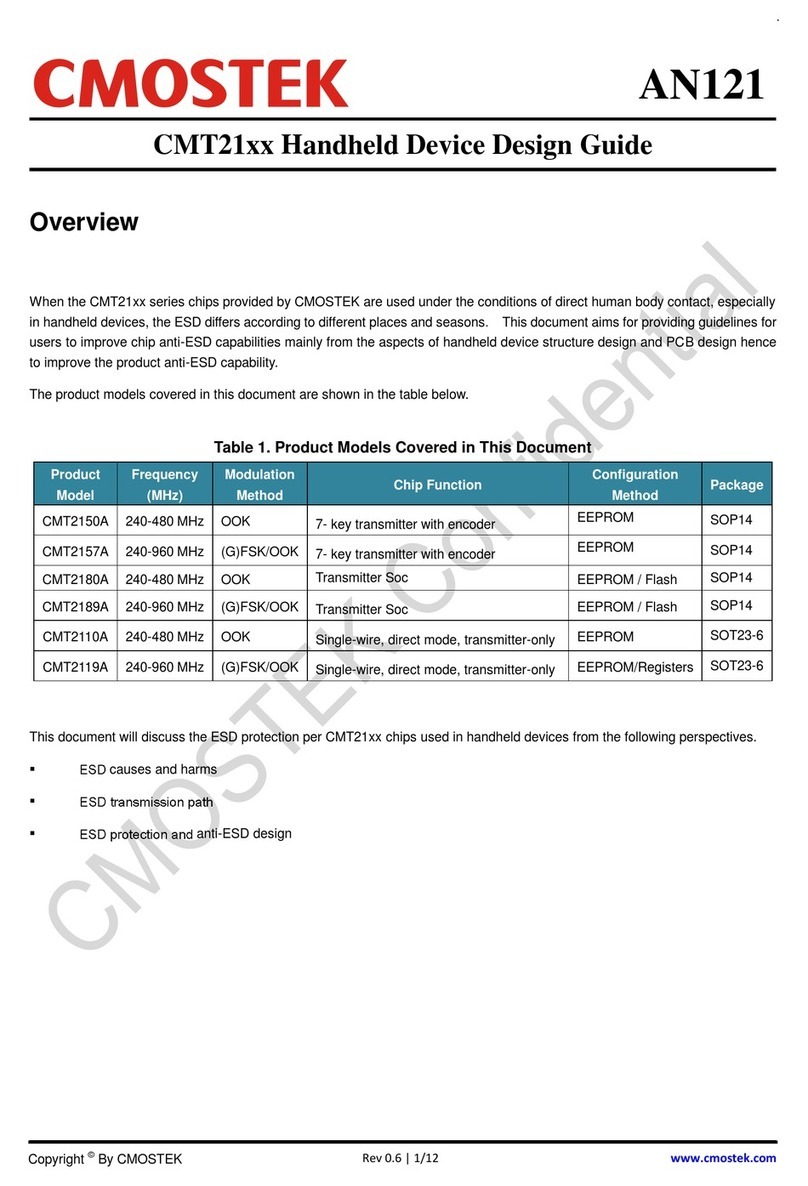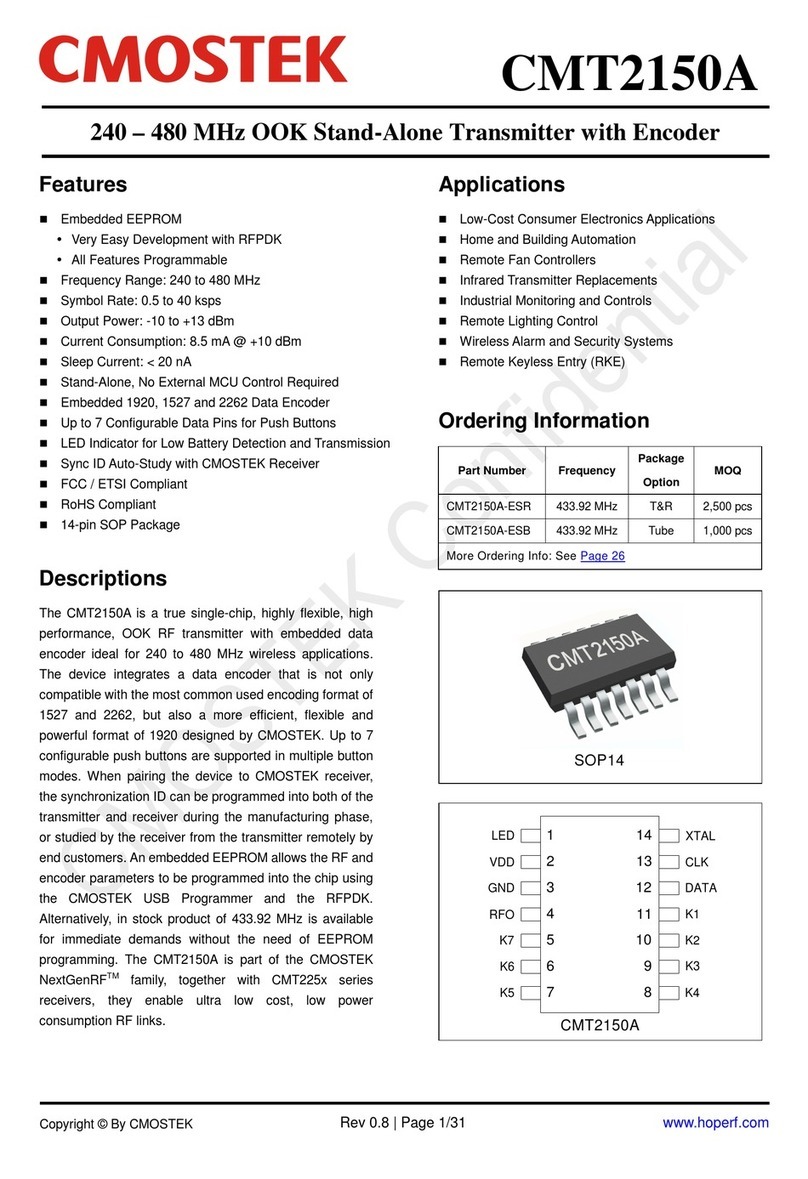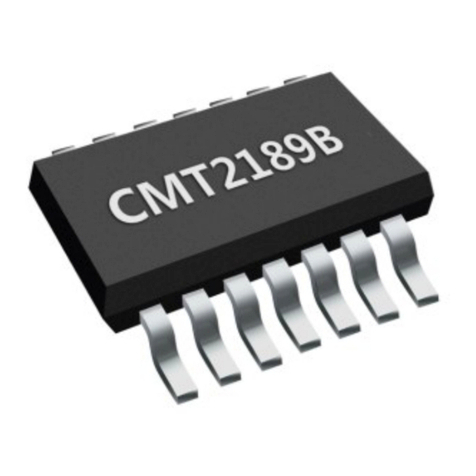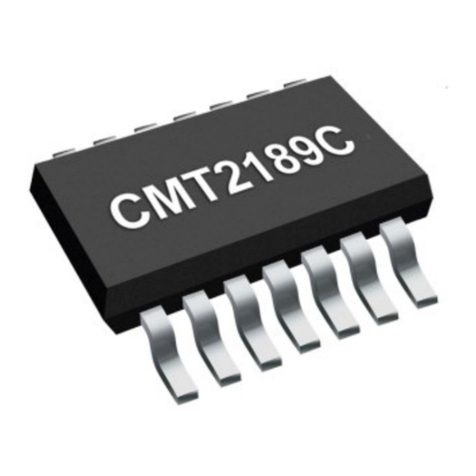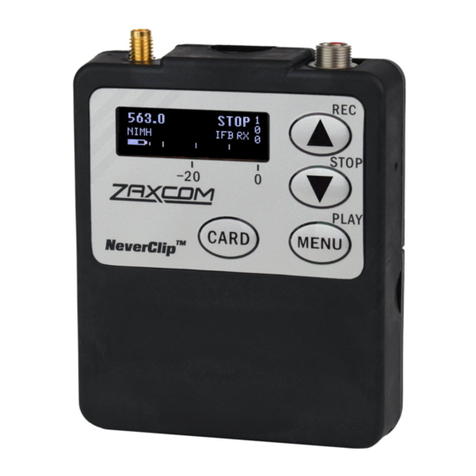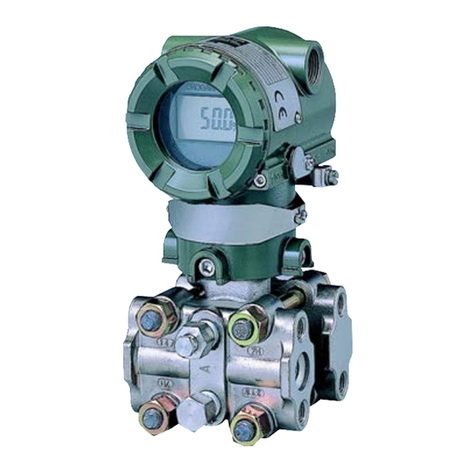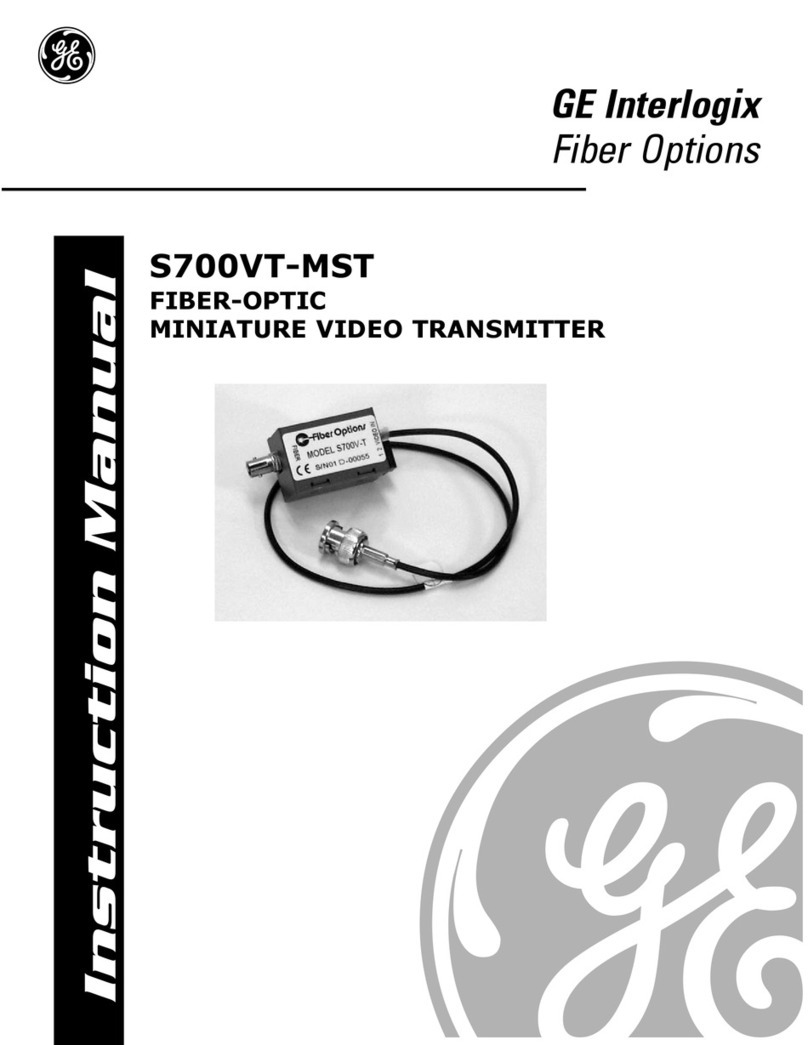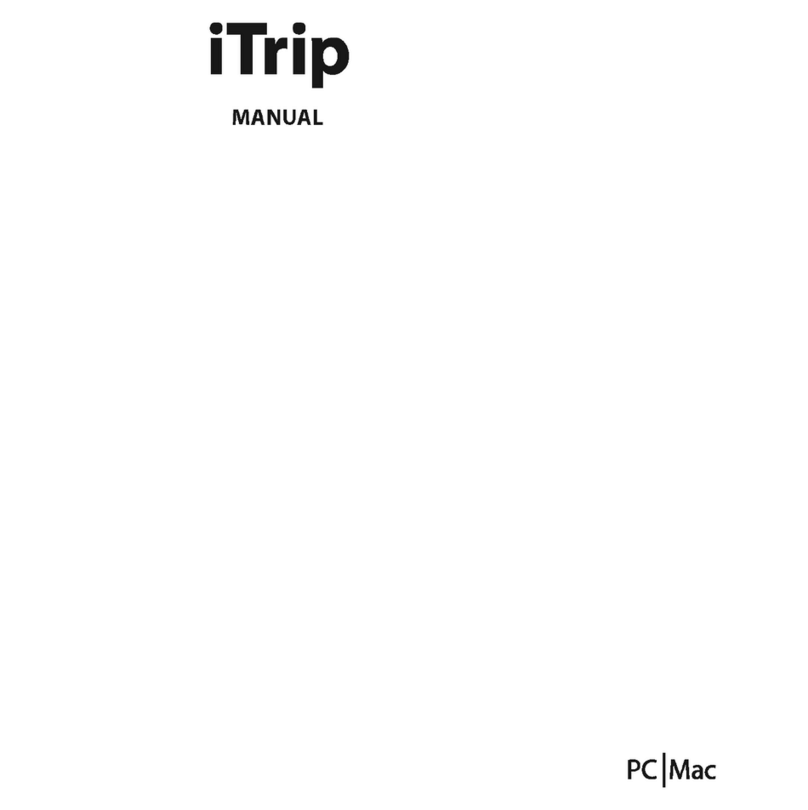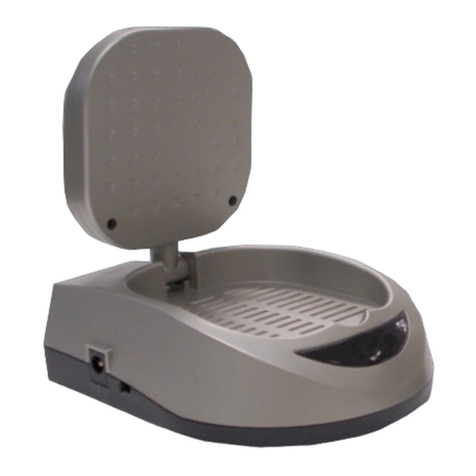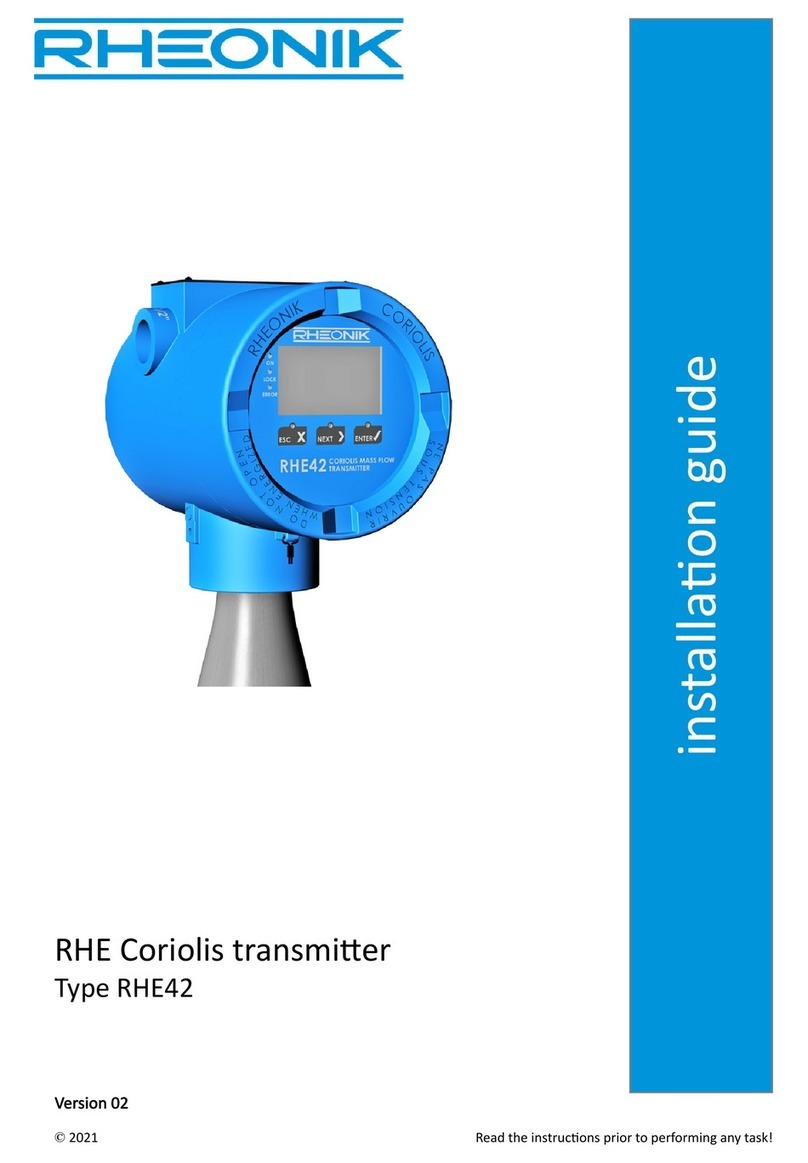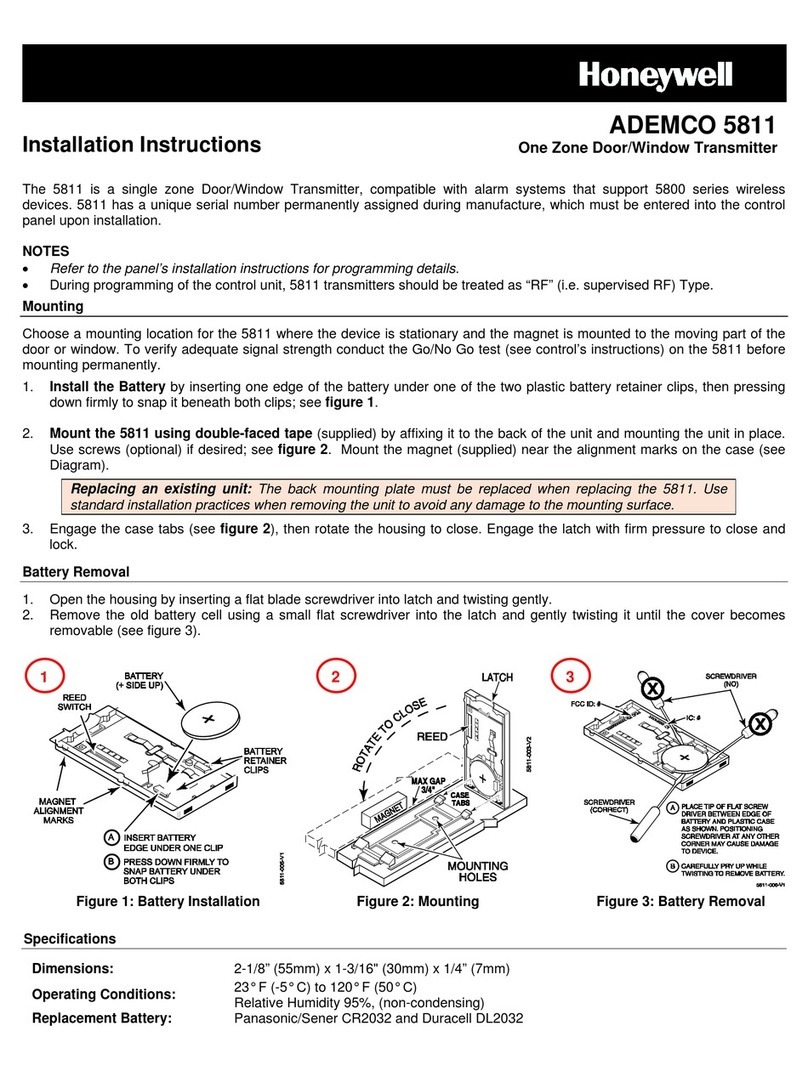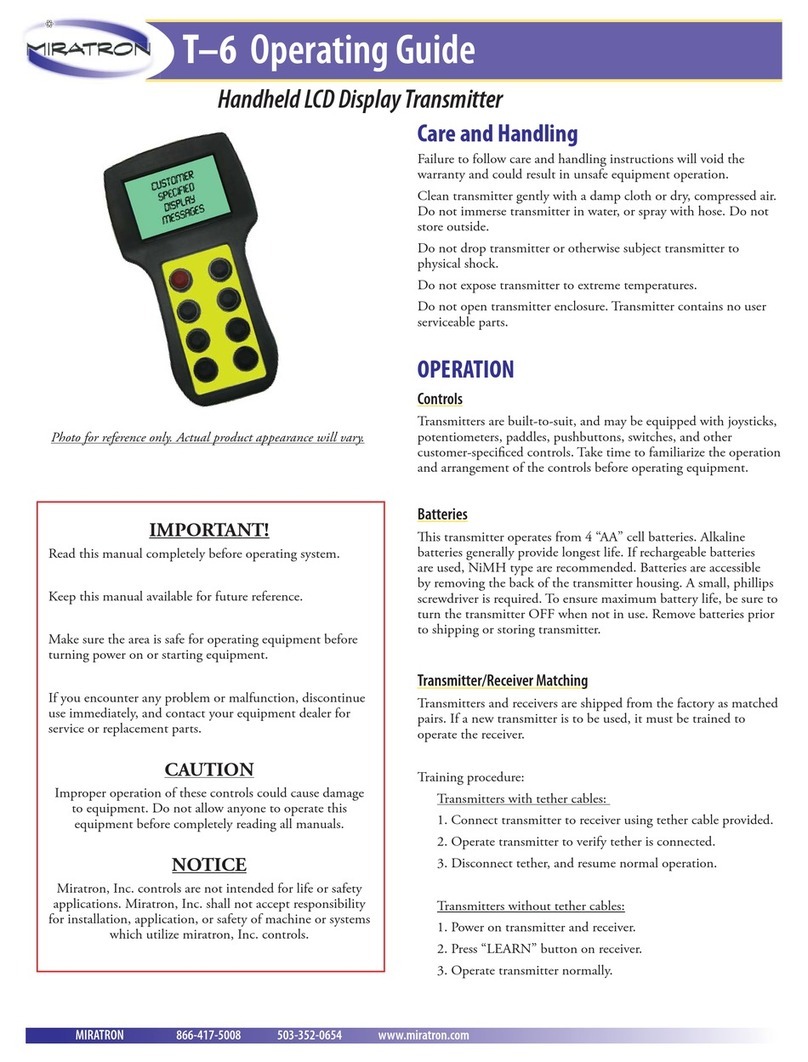CMOSTEK CMT2157AW User manual

CMT2157AW
Rev 0.8 | Page 1/31
www.hoperf.com
CMT2157AW
240 – 960 MHz (G)FSK/OOK Stand-Alone Transmitter with Encoder
Copyright © By CMOSTEK
Features
Embedded EEPROM
Very Easy Development with RFPDK
All Features Programmable
Frequency Range: 240 to 960 MHz
FSK, GFSK and OOK Modulation
Symbol Rate:
0.5 to 100 ksps (FSK/GFSK)
0.5 to 40 ksps (OOK)
Deviation: 1.0 to 200 kHz
Output Power: -10 to +13 dBm
Sleep Current: < 20 nA
Stand-Alone, No External MCU Control Required
Embedded 1920, 1527 and 2262 Data Encoder
Up to 7 Configurable Data Pins for Push Buttons
LED Indicator for Low Battery Detection and Transmission
Sync ID Auto-Study with CMOSTEK Receiver
FCC / ETSI Compliant
RoHS Compliant
14-pin SOP Package
Applications
Low-Cost Consumer Electronics Applications
Home and Building Automation
Remote Fan Controllers
Infrared Transmitter Replacements
Industrial Monitoring and Controls
Remote Lighting Control
Wireless Alarm and Security Systems
Remote Keyless Entry (RKE)
Descriptions
The CMT2157AW is a true single-chip, highly flexible, high
performance, (G)FSK/OOK RF transmitter with embedded
data encoder ideally for 240 to 960 MHz wireless
applications. The device integrates a data encoder that is
not only compatible with the most common used encoding
format of 1527 and 2262, but also a more efficient, flexible
and powerful format of 1920 designed by CMOSTEK. Up
to 7 configurable push buttons are supported in multiple
button modes. When pairing the device to CMOSTEK
receiver, the synchronization ID can be programmed into
both of the transmitter and receiver during the
manufacturing phase, or studied by the receiver from the
transmitter remotely by end customers. An embedded
EEPROM allows the RF and encoder parameters to be
programmed into the chip using the CMOSTEK USB
Programmer and the RFPDK. Alternatively, in stock
product of 868.35 MHz is available for immediate demands
without the need of EEPROM programming. The
CMT2157AW is part of the CMOSTEK NextGenRFTM
family, together with CMT225x series receivers, they
enable ultra low cost, low power consumption RF links.
Ordering Information
Part Number Frequency Package MOQ
CMT2157AW-ESR 868.35 MHz T&R 2,500 pcs
CMT2157AW-ESB 868.35 MHz Tube 1,000 pcs
More Ordering Info: See Page 26
1
2
3
4
5
6
7
14
13
12
10
9
8
11
LED
VDD
GND
RFO
K7
K6
K5
XTAL
CLK
DATA
K1
K2
K3
K4
CMT2157AW
SOP14

CMT2157AW
Rev 0.8 | Page 2/31
www.hoperf.com
Typical Application
ANT VDD
U1
C2
L2 C1
L1 C0
SW7
SW6
SW5
LED
VDD
GND
RFO
K7
K6
K5
1
2
3
4
5
6
7
D1
8
9
10
11
12
13
14
SW4
SW3
SW2
SW1
XTAL
CLK
DATA
K1
K2
K3
K4
X1
CLK
DATA
CLK
DATA
J1
1
2
3
4
VDD
CMT2157AW
Note: Connector J1 is for
EEPROM Programming
Figure 1. CMT2157AW Typical Application Schematic
Table 1. BOM of 433.92/868.35 MHz Typical Application
Designator Descriptions Value
Unit Manufacturer
433.92 MHz
868.35 MHz
U1 CMT2157AW, 240 – 960 MHz (G)FSK/OOK
stand-alone transmitter with encoder
- - CMOSTEK
X1 ±20 ppm, SMD32*25 mm crystal 26 MHz EPSON
C0 ±20%, 0402 X7R, 25 V 0.1 uF Murata GRM15
C1 ±5%, 0402 NP0, 50 V 82 82 pF Murata GRM15
C2 ±5%, 0402 NP0, 50 V 9.1 3.9 pF Murata GRM15
L1 ±5%, 0603 multi-layer chip inductor 180 100 nH Murata LQG18
L2 ±5%, 0603 multi-layer chip inductor 22 5.1 nH Murata LQG18
D1 D0603, red LED - - -
SW[7:1] Push buttons - - -

CMT2157AW
Rev 0.8 | Page 3/31
www.hoperf.com
Abbreviations
Abbreviations used in this data sheet are described below
AN Application Notes OBW Occupied Bandwidth
BOM
Bill of Materials
OOK
On-Off Keying
BSC Basic Spacing between Centers PA Power Amplifier
BW
Bandwidth
PC
Personal Computer
DC Direct Current PCB Printed Circuit Board
EEPROM Electrically Erasable Programmable Read-Only
Memory
PLL
Phase Lock Loop
PN Phase Noise
ESD
Electro-Static Discharge
RBW
Resolution Bandwidth
ESR Equivalent Series Resistance RCLK Reference Clock
FSK
Frequency Shift Keying
RF
Radio Frequency
GFSK Gauss Frequency Shift Keying RFPDK RF Product Development Kit
GUI
Graphical User Interface
RoHS
Restriction of Hazardous Substances
IC Integrated Circuit Rx Receiving, Receiver
LDO
Low Drop-Out
SOT
Small-Outline Transistor
Max Maximum TBD To Be Determined
MCU
Microcontroller Unit
Tx
Transmission, Transmitter
Min Minimum Typ Typical
MOQ
Minimum Order Quantity
XO/XOSC
Crystal Oscillator
NP0 Negative-Positive-Zero XTAL Crystal

CMT2157AW
Rev 0.8 | Page 4/31
www.hoperf.com
Table of Contents
1. Electrical Characteristics............................................................................................................................................ 5
1.1 Recommended Operating Conditions...................................................................................................................5
1.2 Absolute Maximum Ratings................................................................................................................................... 5
1.3 Transmitter Specifications..................................................................................................................................... 6
1.4 Crystal Oscillator...................................................................................................................................................7
2. Pin Descriptions .......................................................................................................................................................... 8
3. Typical Performance Characteristics......................................................................................................................... 9
4. Typical Application Schematics............................................................................................................................... 10
4.1 Low-Cost Application Schematic......................................................................................................................... 10
4.2 FCC/ETSI Compliant Application Schematic....................................................................................................... 11
5. Functional Descriptions............................................................................................................................................ 12
5.1 Overview............................................................................................................................................................. 12
5.2 Modulation, Frequency, Deviation and Symbol Rate .......................................................................................... 12
5.3 Embedded EEPROM and RFPDK...................................................................................................................... 13
5.4 Power Amplifier................................................................................................................................................... 15
5.5 PA Ramping........................................................................................................................................................ 15
5.6 Working States.................................................................................................................................................... 16
5.7 The Encoder........................................................................................................................................................ 17
5.7.1 1920 Packet Structure............................................................................................................................................17
5.7.2 1527 Packet Structure............................................................................................................................................18
5.7.32262 Packet Structure............................................................................................................................................19
5.8 ID Study.............................................................................................................................................................. 20
5.9 Button Modes...................................................................................................................................................... 21
5.9.1 Normal......................................................................................................................................................................21
5.9.2 Matrix........................................................................................................................................................................22
5.9.3 Toggle.......................................................................................................................................................................23
5.9.4 PWM.........................................................................................................................................................................23
5.10 LED Driving Capability........................................................................................................................................ 24
5.11 Low Battery Detection (LBD)............................................................................................................................... 24
5.12 Crystal Oscillator and RCLK................................................................................................................................ 24
6. Ordering Information................................................................................................................................................. 26
7. Package Outline......................................................................................................................................................... 27
8. Top Marking ............................................................................................................................................................... 28
8.1 CMT2157AW Top Marking.................................................................................................................................. 28
9. Other Documentations.............................................................................................................................................. 29
10.Document Change List.............................................................................................................................................. 30
11. Contact Information .................................................................................................................................................. 31

CMT2157AW
Rev 0.8 | Page 5/31
www.hoperf.com
1. Electrical Characteristics
VDD = 3.3 V, TOP = 25 ℃, FRF = 433.92 MHz, output power is +10 dBm terminated in a matched 50 Ω impedance, unless
otherwise noted.
1.1 Recommended Operating Conditions
Table 2. Recommended Operation Conditions
Parameter Symbol Conditions Min Typ Max Unit
Operation Voltage Supply VDD
1.8 3.6 V
Operation Temperature TOP
-40 85 ℃
Supply Voltage Slew Rate 1mV/us
1.2 Absolute Maximum Ratings
Table 3. Absolute Maximum Ratings[1]
Parameter Symbol Conditions Min Max Unit
Supply Voltage VDD
-0.3 3.6 V
Interface Voltage VIN
-0.3 VDD + 0.3 V
Junction Temperature TJ-40 125 ℃
Storage Temperature TSTG
-50 150 ℃
Soldering Temperature TSDR Lasts at least 30 seconds 255 ℃
ESD Rating Human Body Model (HBM) -2 2 kV
Latch-up Current @ 85 ℃-100 100 mA
Note:
[1]. Stresses above those listed as “absolute maximum ratings” may cause permanent damage to the device. This is a stress
rating only and functional operation of the device under these conditions is not implied. Exposure to maximum rating
conditions for extended periods may affect device reliability.
Caution! ESD sensitive device. Precaution should be used when handling the device in order
to prevent permanent damage.

CMT2157AW
Rev 0.8 | Page 6/31
www.hoperf.com
1.3 Transmitter Specifications
Table 4. Transmitter Specifications
Parameter Symbol Conditions Min Typ Max Unit
Frequency Range[1] FRF 240 960MHz
Synthesizer Frequency
Resolution FRES FRF ≤480 MHz 198 Hz
FRF > 480 MHz 397 Hz
Symbol Rate SR FSK/GFSK 0.5 100 ksps
OOK 0.5 40 ksps
(G)FSK Modulation
Deviation Range FDEV 1 200 kHz
Bandwidth-Time Product BT GFSK modulation - 0.5 - -
Maximum Output Power POUT(Max) +13 dBm
Minimum Output Power POUT(Min) -10 dBm
Output Power Step Size PSTEP
1dB
PA Ramping Time[2] tRAMP
01024 us
Current Consumption[3]
@ 433.92 MHz IDD-433.92
OOK, 0 dBm 6 mA
OOK, +10 dBm 8.5 mA
OOK, +13 dBm 10.2 mA
FSK, 0 dBm 10.8 mA
FSK, +10 dBm 23.8 mA
FSK, +13 dBm 32 mA
Current Consumption[3]
@ 868.35 MHz IDD-868.35
OOK, 0 dBm 6.1 mA
OOK, +10 dBm 9.3 mA
OOK, +13 dBm 11.2 mA
FSK, 0 dBm 12.3 mA
FSK, +10 dBm 26.7 mA
FSK, +13 dBm 35.3 mA
Sleep Current ISLEEP 20 nA
Frequency Tune Time tTUNE
370 us
Phase Noise @ 433.92
MHz PN433.92
100 kHz offset from FRF -80 dBc/Hz
600 kHz offset from FRF
-96
dBc/Hz
1.2 MHz offset from FRF -108dBc/Hz
Phase Noise @ 868.35
MHz PN868.35
100 kHz offset from FRF -74 dBc/Hz
600 kHz offset from FRF -90 dBc/Hz
1.2 MHz offset from FRF -102 dBc/Hz
Harmonics Output for
433.92 MHz[4] H2433.92 2nd harm @ 867.84 MHz, +13 dBm POUT -52 dBm
H3433.92
3rd harm @ 1301.76 MHz, +13 dBm POUT -57 dBm
Harmonics Output for
868.35 MHz[4] H2868.35 2nd harm @ 1736.7 MHz, +13 dBm POUT -68 dBm
H3868.35 3rd harm @ 2605.05 MHz, +13 dBm POUT -52 dBm
OOK Extinction Ration 60 dB
Notes:
[1]. The frequency range is continuous over the specified range.
[2]. 0 and 2nus, n = 0 to 10, when set to “0”, the PA output power will ramp to its configured value in the shortest possible
time.
[3]. The working currents are tested with: 1527 packet format/Normal button mode/ 4 push buttons/Sync ID = 0/No LED.
[4]. The harmonics output is measured with the application shown as Figure 10.

CMT2157AW
Rev 0.8 | Page 7/31
www.hoperf.com
1.4 Crystal Oscillator
Table 5. Crystal Oscillator Specifications
Parameter Symbol Conditions Min Typ Max Unit
Crystal Frequency[1] FXTAL 26 26 26 MHz
Crystal Tolerance[2] ±20 ppm
Load Capacitance[3] CLOAD
12
20 pF
Crystal ESR Rm 60 Ω
XTAL Startup Time[4] tXTAL 400 us
Notes:
[1]. The CMT2157AW can directly work with external 26 MHz reference clock input to XTAL pin (a coupling capacitor is
required) with amplitude 0.3 to 0.7 Vpp.
[2]. This is the total tolerance including (1) initial tolerance, (2) crystal loading, (3) aging, and (4) temperature dependence.
The acceptable crystal tolerance depends on RF frequency and channel spacing/bandwidth.
[3]. The required crystal load capacitance is integrated on-chip to minimize the number of external components.
[4]. This parameter is to a large degree crystal dependent.

CMT2157AW
Rev 0.8 | Page 8/31
www.hoperf.com
2. Pin Descriptions
1
2
3
4
5
6
7
14
13
12
10
9
8
11
LED
VDD
GND
RFO
K7
K6
K5
XTAL
CLK
DATA
K1
K2
K3
K4
Figure 2. CMT2157AW Pin Assignments
Table 6. CMT2157AW Pin Descriptions
Pin Number Name I/O Descriptions
1 LED O LED driver, active low
2 VDD I Power supply input
3 GND I Ground
4 RFO O Power amplifier output
5 - 11 K[7:1] I Push button 7 to 1
12 DATA IO Data pin to access the embedded EEPROM, internally pulled up to VDD
13 CLK I Clock pin to access the embedded EEPROM, internally pulled up to VDD
14 XTAL I 26 MHz single-ended crystal oscillator input or
External 26 MHz reference clock input

CMT2157AW
Rev 0.8 | Page 9/31
www.hoperf.com
3. Typical Performance Characteristics
13.4dBm
@ 433.92 MHz
-56.8 dBm
@ 435.12 MHz
-60
-50
-40
-30
-20
-10
0
10
20
432.42 432.72 433.02 433.32 433.62 433.92 434.22 434.52 434.82 435.12 435.42
Power(dBm)
Frequency (MHz)
Phase Noise @ 433.92 MHz
13.0 dBm
@ 868.35 MHz
-55.9 dBm
@ 869.55 MHz
-65
-55
-45
-35
-25
-15
-5
5
15
866.85 867.1 867.35 867.6 867.85 868.1 868.35 868.6 868.85 869.1 869.35 869.6 869.85
Power(dBm)
Frequency (MHz)
Phase Noise @ 868.35 MHz
-60
-50
-40
-30
-20
-10
0
10
20
432.92 433.12 433.32 433.52 433.72 433.92 434.12 434.32 434.52 434.72 434.92
Power(dBm)
Frequency (MHz)
OOK Spectrum
-50
-40
-30
-20
-10
0
10
20
433.62 433.72 433.82 433.92 434.02 434.12 434.22
Power (dBm)
Frequency (MHz)
FSK vs. GFSK
FSK
GFSK
-50
-40
-30
-20
-10
0
10
433.17 433.37 433.57 433.77 433.97 434.17 434.37 434.57
Power (dBm)
Frequency (MHz)
Spectrum of Various PA Ramping Options
1024 us
512 us
256 us
128 us
64 us
32 us
SR= 1.2 ksps
-2
0
2
4
6
8
10
12
14
16
1.6 1.8 22.2 2.4 2.6 2.8 33.2 3.4 3.6 3.8
Power(dBm)
SupplyVoltage (V)
POUT vs. VDD
13dBm
10dBm
0dBm
Figure 3. Phase Noise, FRF = 868.35 MHz,
POUT = +13 dBm, RBW = 10 kHz, Un-encoded
Figure 5. OOK Spectrum,
POUT = +10 dBm, tRAMP = 32 us
Figure 6. FSK/GFSK Spectrum,
SR = 9.6 ksps, FDEV = 15 kHz
Figure 7. Spectrum of PA Ramping,
SR = 1.2 ksps, POUT = +10 dBm
Figure 4. Phase Noise, FRF = 433.92 MHz,
POUT = +13 dBm, RBW = 10 kHz, Un-encoded
Figure 8. Output Power vs. Supply
Voltages, FRF = 433.92 MHz

CMT2157AW
Rev 0.8 | Page 10/31
www.hoperf.com
4. Typical Application Schematics
4.1 Low-Cost Application Schematic
ANT VDD
U1
C2
L2 C1
L1 C0
SW7
SW6
SW5
LED
VDD
GND
RFO
K7
K6
K5
1
2
3
4
5
6
7
D1
8
9
10
11
12
13
14
SW4
SW3
SW2
SW1
XTAL
CLK
DATA
K1
K2
K3
K4
X1
CLK
DATA
CLK
DATA
J1
1
2
3
4
VDD
CMT2157AW
Note: Connector J1 is for
EEPROM Programming
Figure 9. Low-Cost Application Schematic
Notes:
1. Connector J1 is a must for the CMT2157AW EEPROM access during development or manufacture phase.
2. The general layout guidelines are listed below. For more design details, please refer to “AN111 CMT215x Schematic and
PCB Layout Design Guideline”
Use as much continuous ground plane metallization as possible.
Use as many grounding vias (especially near to the GND pins) as possible to minimize series parasitic inductance
between the ground pour and the GND pins.
Avoid using long and/or thin transmission lines to connect the components.
Avoid placing the nearby inductors in the same orientation to reduce the coupling between them.
Place C0 as close to the CMT2157AW as possible for better filtering.
3. The table below shows the BOM of 433.92/868.35 MHz Low-Cost Application. For the BOM of more applications, please
refer to “AN111 CMT215x Schematic and PCB Layout Design Guideline”.
Table 7. BOM of 433.92/868.35 MHz Low-Cost Application
Designator Descriptions Value
Unit Manufacturer
433.92 MHz
868.35 MHz
U1 CMT2157AW, 240 – 960 MHz (G)FSK/OOK
stand-alone transmitter with encoder - - CMOSTEK
X1 ±20 ppm, SMD32*25 mm crystal 26 MHz EPSON
C0 ±20%, 0402 X7R, 25 V 0.1 uF Murata GRM15
C1 ±5%, 0402 NP0, 50 V 82 82 pF Murata GRM15
C2 ±5%, 0402 NP0, 50 V 9.1 3.9 pF Murata GRM15
L1 ±5%, 0603 multi-layer chip inductor 180 100 nH Murata LQG18
L2 ±5%, 0603 multi-layer chip inductor 22 5.1 nH Murata LQG18
D1 D0603, red LED - - -
SW[7:1] Push buttons - - -

CMT2157AW
Rev 0.8 | Page 11/31
www.hoperf.com
4.2 FCC/ETSI Compliant Application Schematic
VDD
U1
C2
L2 C1
L1 C0
SW7
SW6
SW5
LED
VDD
GND
RFO
K7
K6
K5
1
2
3
4
5
6
7
D1
8
9
10
11
12
13
14
SW4
SW3
SW2
SW1
XTAL
CLK
DATA
K1
K2
K3
K4
X1
CLK
DATA
CMT2157AW
ANT
L3
C3
CLK
DATA
J1
1
2
3
4
VDD
Note: Connector J1 is for
EEPROM Programming
Figure 10. FCC/ETSI Compliant Application Schematic
Notes:
1. Connector J1 is a must for the CMT2157AW EEPROM access during development or manufacture phase.
2. The general layout guidelines are listed below. For more design details, please refer to “AN111 CMT215x Schematic and
PCB Layout Design Guideline”.
Use as much continuous ground plane metallization as possible.
Use as many grounding vias (especially near to the GND pins) as possible to minimize series parasitic inductance
between the ground pour and the GND pins.
Avoid using long and/or thin transmission lines to connect the components.
Avoid placing the nearby inductors in the same orientation to reduce the coupling between them.
Place C0 as close to the CMT2157AW as possible for better filtering.
3. The table below shows the BOM of 433.92/868.35 MHz FCC/ETSI Compliant Application. For the BOM of more
application, please refer to “AN111 CMT215x Schematic and PCB Layout Design Guideline”.
Table 8. BOM of 433.92/868.35 MHz FCC/ETSI Compliant Application
Designator Descriptions Value
Unit Manufacturer
433.92 MHz 868.35 MHz
U1 CMT2157AW, 240 – 960 MHz (G)FSK/OOK
stand-alone transmitter with encoder - - CMOSTEK
X1 ±20 ppm, SMD32*25 mm crystal 26 MHz EPSON
C0 ±20%, 0402 X7R, 25 V 0.1 uF Murata GRM15
C1
±5%, 0402 NP0, 50 V
68
68 pF
Murata GRM15
C2 ±5%, 0402 NP0, 50 V 15 10 pF Murata GRM15
C3 ±5%, 0402 NP0, 50 V 15 6.8 pF Murata GRM15
L1
±5%, 0603 multi-layer chip inductor
180
100 nH
Murata LQG18
L2 ±5%, 0603 multi-layer chip inductor 36 5.6 nH Murata LQG18
L3 ±5%, 0603 multi-layer chip inductor 18 6.8 nH Murata LQG18
D1 D0603, red LED - - -
SW[7:0] Push buttons - - -

CMT2157AW
Rev 0.8 | Page 12/31
www.hoperf.com
5. Functional Descriptions
Modulator
LDOs
VDD
GND
CLK
K0/DATA
XTAL RFO
Loop
Filter
PFD/CP
Frac-N DIV
Encoder Ramp-control
Interface & Control Logics
EEPROM
POR
PA
VCOXOSC
Bandgap LED Driver LED
K[7:1]
K0
Figure 11. CMT2157AW Functional Block Diagram
5.1 Overview
The CMT2157AW is a true single-chip, highly flexible, high performance, OOK RF transmitter with embedded data encoder
ideal for 240 to 960 MHz wireless applications. It is part of the CMOSTEK NextGenRFTM family, which includes a complete line
of transmitters, receivers and transceivers. The device integrates a data encoder that is not only compatible with the most
common used encoding format of 1527 and 2262, but also a more efficient, flexible and powerful format of 1920 designed by
CMOSTEK. Up to 7 configurable push buttons are supported in multiple button modes. The device is optimized for the low
system cost, low power consumption, battery powered application with its highly integrated and low power design.
The functional block diagram of the CMT2157AW is shown in figure above. The CMT2157AW is based on direct synthesis of
the RF frequency by means of a fully integrated low-noise fractional-N frequency synthesizer. It uses a 1-pin crystal oscillator
circuit with the required crystal load capacitance integrated on-chip to minimize the number of external components. Every
analog block is calibrated on each Power-on Reset (POR) to an internal reference voltage source. The calibration can help the
chip to finely work under different temperatures and supply voltages. The transmission is triggered by pressing the push
button(s). The data is modulated and sent out by a highly efficient PA which output power can be configured from -10 to +13
dBm in 1 dB step size. RF Frequency, PA output power and other product features can be programmed into the embedded
EEPROM by the RFPDK and USB Programmer.This saves the cost and simplifies the product development and
manufacturing effort. Alternatively, in stock product of 868.35 MHz is available for immediate demands with no need of
EEPROM programming. The CMT2157AW operates from 1.8 to 3.6 V so that it can finely work with most batteries to their
useful power limits. It only consumes 26.7 mA when transmitting +10 dBm FSK signal at 868.35 MHz under 3.3 V supply
voltage.
5.2 Modulation, Frequency, Deviation and Symbol Rate
The CMT2157AW supports GFSK/FSK modulation with the symbol rate up to 100 ksps, as well as OOK modulation with the
symbol rate up to 40 ksps. The supported deviation of the (G)FSK modulation ranges from 1 to 200 kHz. It continuously covers
the frequency range from 240 to 960 MHz, including the license free ISM frequency band around 315 MHz, 433.92 MHz,
868.35 MHz and 915 MHz. The device contains a high spectrum purity low power fractional-N frequency synthesizer with
output frequency resolution better than 198 Hz when the frequency is less than 480 MHz, and is about 397 Hz when the
frequency is larger than 480 MHz. See Table 9 for the modulation, frequency, deviation and symbol rate specifications.

CMT2157AW
Rev 0.8 | Page 13/31
www.hoperf.com
Table 9. Modulation, Frequency, Deviation and Symbol Rate
Parameter
Value
Unit
Modulation
(G)FSK/OOK
-
Frequency
240 to 960
MHz
Deviation 1 to 200 kHz
Frequency Resolution (FRF ≤480 MHz)
198
Hz
Frequency Resolution (FRF > 480 MHz)
397
Hz
Symbol Rate (FSK/GFSK)
0.5 to 100
ksps
Symbol Rate (OOK)
0.5 to 40
ksps
5.3 Embedded EEPROM and RFPDK
The RFPDK (RF Products Development Kit) is a very user-friendly software tool delivered for the user configuring the
CMT2157AW in the most intuitional way. The user only needs to fill in/select the proper value of each parameter and click the
“Burn” button to complete the chip configuration. No register access and control is required in the application program. See
figure below for the accessing of the EEPROM and Table 10 for the summary of all the configurable parameters of the
CMT2157AW on the RFPDK.
CMT2157AW
Interface
CMOSTEK USB
Programmer
CLK
DATA
RFPDK
EEPROM
Figure 12. Accessing Embedded EEPROM
For more details of the CMOSTEK USB Programmer and the RFPDK, please refer to “AN113 CMT2150A/2250(1)A One-Way
RF Link Development Kits User’s Guide”. For the detail of CMT2157AW configurations with the RFPDK, please refer to
“AN142 CMT2157A Configuration Guideline”.
Table 10. Configurable Parameters in RFPDK
Category Parameters Descriptions Default Mode
RF Settings
Frequency To input a desired transmitting radio frequency in
the range from 240 to 960 MHz. The step size is
0.001 MHz. 868.35 MHz Basic
Advanced
Modulation The option is FSK or GFSK and OOK. FSK Basic
Advanced
Tx Power To select a proper transmitting output power from
-10 dBm to +14 dBm, 1 dBm margin is given
above +13 dBm. +13 dBm Basic
Advanced
Xtal Cload On-chip XOSC load capacitance options: from 10
to 22 pF. 15.00 pF Basic
Advanced
Symbol Rate To determines the symbol rate of the transmitted
data: from 0.5 to 100 ksps in (G)FSK mode and
0.5 to 40 ksps in OOK mode. 2.4 Basic
Advanced

CMT2157AW
Rev 0.8 | Page 14/31
www.hoperf.com
Category Parameters Descriptions Default Mode
Deviation The FSK frequency deviation. The range is from
1 to 200 kHz. 35 kHz Basic
Advanced
PA Ramping To control PA output power ramp up/down time,
options are 0 and 2nus (n from 0 to 10). 0 us Advanced
LED Driving
Capability This defines the driving current of the LED pin.
The options are: Disable, 5, 10, 15 or 20 mA. 5 mA Advanced
LBD Threshold This defines the Low Battery Detection threshold.
The options are: Disable, 1.7, 1.8, 1.9, 2.0, 2.1,
2.2, 2.3, 2.4, 2.5, 2.6, 2.7 or 2.8 V. 2.4 V Advanced
Data
Representation
To select whether the frequency “Fo + Fdev”
represent data 0 or 1. The options are:
0: F-high 1: F-low, or
0: F-low 1: F-high.
0: F-low
1: F-high Advanced
Encoder
Settings
Encoder
Select the packet encoding format, the options
are: 1920, 1527 and 2262. See Table 13, Table
14 and Table 15 for the configurable parameters
in each packet.
1527 Basic
Advanced
Bit Format
This tells the device how many symbols are used
to construct a single bit in the 1920 mode. The
options are: 3, 4, 5 or 6 sym/bit. The Bit Format is
fixed at 4 sym/bit in 1527 mode and 8 sym/bit in
2262 mode. It is only available in 1920 mode.
3 Basic
Advanced
Number of
Packets
This defines the minimum number of packet(s)
being transmitted during each button pressing
action. It also defines the number of packet(s)
being transmitted during each periodic
transmission. The range is from 1 to 256.
1 Advanced
Packet Interval
This defines the time interval amount two
consecutive transmitted packets. The unit is in
symbol, the range is from 0 to 255 symbols of
zero.
0 symbols of
zero Basic
Advanced
Push Button
Settings
Button Mode
Select the button encoding mode, the options
are: Normal, Matrix, Toggle and PWM. For 1920
and 1527 format, all these button modes are
supported; For 2262 format, only Normal button
mode is supported.
Normal Basic
Advanced
On/Off
Button(s)
Select the numbers of on/off button for Toggle
and PWM button modes, the options are: Single
or Separated. Single Basic
Advanced
Number of
Button(s)
This option is only available in Normal Button
Mode, and Encoder is set to 1920 and 1527. It
defines the number of activated button(s) to be
used in the application. The range is from 1 to 7.
4 Basic
Advanced
Data Inversion Allow the user to select whether or not to inverse
the transmitted data bits values in the Normal and
Toggle Button Mode. The options are: No or Yes. No Advanced
Periodic
Transmission Turn on/off the periodic transmission mode of the
device. The options are: On or Off. Off Advanced

CMT2157AW
Rev 0.8 | Page 15/31
www.hoperf.com
Category Parameters Descriptions Default Mode
Periodic Time
This parameter is only available when Periodic
Transmission is turned on. It defines the periodic
time for transmitting a fixed set of data. The
range is from 2 to 7683.512 s, accurate to 3
decimal points. It is only available when Periodic
Transmission is on.
1.000 s Advanced
Study Settings
ID Study Turn on/off the Sync ID study function, the
options are: On or Off. The ID Study is only
supported in 1920 and 1527 mode. Off Advanced
Study Trigger
Time
This parameter is only available when ID Study is
turned on. It defines the time from the instance of
pressing the study button to the instance at which
the device starts to transmit the study packets.
The range is from 1 to 15 second(s).
5 s Advanced
Study Button
This parameter is only available when ID Study is
turned on. It defines which button is used to
trigger the transmission of the study packets. The
options are the current buttons used in the Push
Button Settings.
Pin 11 (K1) Advanced
Study Power
This parameter is only available when ID Study is
turned on. It defines the PA power when the
device is transmitting the study packets. The
range is from –10 to +14 dBm.
-6 dBm Basic
Advanced
5.4 Power Amplifier
A highly efficient single-ended Power Amplifier (PA) is integrated in the CMT2157AW to transmit the modulated signal out.
Depending on the application, the user can design a matching network for the PA to exhibit optimum efficiency at the desired
output power for a wide range of antennas, such as loop or monopole antenna. Typical application schematics and the
required BOM are shown in “Chapter 4 Typical Application Schematic”. For the schematic, layout guideline and the other
detailed information please refer to “AN111 CMT215x Schematic and PCB Layout Design Guideline”.
The output power of the PAcan be configured by the user within the range from -10 dBm to +13 dBm in 1 dB step size using
the CMOSTEK USB Programmer and RFPDK.
5.5 PA Ramping
When the PAis switched on or off quickly, its changing input impedance momentarily disturbs the VCO output frequency. This
phenomenon is called VCO pulling, and it manifests as spectral splatter or spurs in the output spectrum around the desired
carrier frequency. By gradually ramping the PAon and off, PA transient spurs are minimized. The CMT2157AW has built-in PA
ramping configurability with options of 0, 1, 2, 4, 8, 16, 32, 64, 128, 256, 512 and 1024 us, as shown in Figure 13. When the
option is set to “0”, the PA output power will ramp up to its configured value in the shortest possible time. The ramp down time
is identical to the ramp up time in the same configuration.
CMOSTEK recommends that the maximum symbol rate should be no higher than 1/2 of the PA ramping “rate”, as shown in the
formula below:
SR
Max
≤ 0.5 * ( 1
t
RAMP
)

CMT2157AW
Rev 0.8 | Page 16/31
www.hoperf.com
In which the PAramping “rate” is given by (1/tRAMP). In other words, by knowing the maximum symbol rate in the application,
the PA ramping time can be calculated by:
t
RAMP
≤ 0.5 * ( 1
SR
MAX
)
The user can select one of the values of the tRAMP in the available options that meet the above requirement. If somehow the
tRAMP is set to be longer than “0.5 * (1/SRMax)”, it will possibly bring additional challenges to the OOK demodulation of the Rx
device. For more detail of calculating tRAMP, please refer to “AN142 CMT2157A Configuration Guideline”.
Time
RFO Amplitude
Time
Data
Logic 1 Logic 0
1024 us
512 us
8 us
4 us
2 us
1 us
0 us
Figure 13. PA Ramping Time
5.6 Working States
The CMT2157AW has following 4 different working states: SLEEP, XO-STARTUP, TUNE and TRANSMIT. The device stays in
the SLEEP state when no transmission is performed. Once the button(s) is/are pressed, the device goes through the sequence
of SLEEP XO-STARTUP TUNE TRANSMIT to transmit the data. After the transmission the device goes back to the
SLEEP state. When the device works in the periodic transmission mode, the device periodically wakes up from the SLEEP
state, goes the same sequence, performs the transmission and goes back to the SLEEP state. All the details of push button(s)
function and periodic transmission can be referred to “AN142 CMT2157A Configuration Guideline”.
SLEEP
When the CMT2157AW is in the SLEEP state, all the internal blocks are turned off and the current consumption is minimized to
20 nA typically.
XO-STARTUP
Once the CMT2157AW received the valid control signal, it will go into the XO-STARTUP state, and the internal XO starts to
work. The user has to wait for the tXTAL to allow the XO to get stable. The tXTAL is to a large degree crystal dependent. A typical
value of tXTAL is provided in the Table 11.
TUNE
The frequency synthesizer will tune the CMT2157AW to the desired frequency in the time tTUNE. The PA can be turned on to
transmit the data generated by the embedded encoder only after the TUNE state is done.
TRANSMIT
The CMT2157AW starts to modulate and transmit the data. The data packets being transmitted are generated by the
embedded encoder, and they are determined by the encoder selected, the button mode and the button being pressed.

CMT2157AW
Rev 0.8 | Page 17/31
www.hoperf.com
Table 11. Main Timing Spec in Different Working States
Parameter Symbol Min Typ Max Unit
XTAL Startup Time [1] tXTAL
400 us
Time to Tune to Desired Frequency[2] tTUNE 370 us
Notes:
[1]. This parameter is to a large degree crystal dependent.
[2]. From XO stable to ready to transmit.
5.7 The Encoder
The device supports 3 types of encoding formats: 1920, 1527 and 2262. The packets of these 3 modes have different
structures which will be introduced in the below sub-sections. The table below summarizes the major features of the 3
encoding formats.
Table 12. Feature Summary of the 3 Encoding Formats
Format Bit Format
(sym/bit)
Sync ID Length
(bits)
Data Length
(bits) CRC ID Study Button Modes[1]
1920 3/4/5/6 1 – 32 1 – 7 Support Support All
1527 4 20 1 – 7 NA Support All
2262 8 6 – 11 1 – 6 NA Not Support Normal Mode
Note:
[1]. Button Modes include Normal Mode, Matrix Mode, Toggle Mode and PWM Mode.
All the details of these 3 types of encoding formats are given in the document “AN142 CMT2157A Configuration Guideline”. The
following sections only give the abstracts of these formats. In the below explanations, some elements in the packet are measured
in the unit of “symbol”, while some of them are measured in the unit of “bit”. For those which have the unit of “bit”, one “bit” is
constructed (encoded) by several “symbols”. In the figures, “SYM” represents the word “symbol”.
5.7.1 1920 Packet Structure
Two types of packet structures are supported for 1920 format: Normal Packet and Study Packet. The following configurable
parameters are shared by the two structures.
Table 13. Configurable Parameters in 1920 Packet
Parameter Descriptions Default Mode
Preamble The size of the valid preamble, the options are: None or
16-symbol. None Basic
Advanced
Address (Sync ID)
Length The range of the Sync ID Length is from 1 to 32 bits. 32-bit Basic
Advanced
Address (Sync ID)
Value The value of the Sync ID has the range from 0 to 2Length-1. 0 Basic
Advanced
Normal Packet
The normal packet is used to control the data pins of the CMOSTEK receiver CMT2250AW or PWM output of the
CMT2251AW. It contains a 16-symbol Preamble, a 32-symbol Head_N (which indicates that the current packet is a normal
packet rather than a study packet), a Sync ID, a Configurable Data Field and an 8-symbol CRC.

CMT2157AW
Rev 0.8 | Page 18/31
www.hoperf.com
Preamble
16 symbols Address (Sync ID)
configurable 1-32 bits D0
1 bit D1
1 bit D2
1 bit D3
1 bit CRC
8 symbols
Head_N
32 symbols
Figure 14. 1920 Normal Packet Structure
Study Packet
The study packet is used for the receiver to learn the Sync ID from the CMT2157AW in order to pair the two devices. It
contains an optional Preamble, a 32-symbol Head_S, a Sync ID and an 8-symbol CRC.
Preamble
(Optional)
16-symbol
CRC
8-symbol
Head_S
32-symbol Address (Sync ID)
configurable 1-32 bits
Figure 15. 1920 Study Packet Structure
Bit Format
In 1920 packet, a single bit can be constructed (encoded) by 3, 4, 5 or 6 symbols. The user can select the desired value of the
“Bit Format” parameter on the RFPDK. Please note that only the Sync ID field and the D0, D1, D2, D3, D4, D5, D6 have the
unit of “bit”.
2 SYM2 SYM1 SYM 1 SYM
Bit 1 Bit 0
1 SYM1 SYM3 SYM 3 SYM
Bit 1 Bit 0
3 SYM2 SYM
Bit 1
2 SYM3 SYM
Bit 0
2 SYM1 SYM
Bit 1
1 SYM 2 SYM 1 SYM1 SYM
Bit 0
1 SYM 3 SYM
3 Symbols/Bit
4 Symbols/Bit
5 Symbols/Bit
6 Symbols/Bit
Figure 16. 1920 Bit Format Options
5.7.2 1527 Packet Structure
Two types of packet structures are supported for 1527 format: Normal Packet and Study Packet. The following configurable
parameter is shared by the two structures.
Table 14. Configurable Parameters in 1527 Packet
Parameter Descriptions Default Mode
Address (Sync ID)
Value The range of the Sync ID value is from 0 to 220-1. This is
because the Sync ID Length is fixed at 20 for 1527. 0 Basic
Advanced
In the traditional 1527 format, 8 OSC clocks are equal to 1 LCK, 4 LCK are equal to 1 symbol. By using the CMT2250AW
pairing with CMT2157AW, the user does not need to adjust the OSC to determine the symbol rate, because the symbol rate is
directly programmed. The Bit Format is fixed at 4 symbols (16 LCK) per bit.

CMT2157AW
Rev 0.8 | Page 19/31
www.hoperf.com
Normal Packet
The traditional 1527 packet contains a 32-symbol Sync, a 20-bit Address (Sync ID) and 4-bit Data. CMOSTEK has defined a
1527 Study Packet to support the ID study in 1527 mode. The traditional packet introduced here is called the “Normal Packet”.
Address (Sync ID)
configurable 20 bits D0
1 bit D1
1 bit D2
1 bit D3
1 bit
Sync
32 symbols
Figure 17. 1527 Normal Packet Structure
Study Packet
The 1527 Study packet contains a 32-symbol Head_S and a 20-bit Address (Sync ID), as shown below.
Head_S
32-symbol Address (Sync ID)
20 bits
Figure 18. 1527 Study Packet Structure
Bit Format
In 1527 packet, a single bit is constructed by 4 symbols, as shown below. The user can select the desired value of the “Bit
Format” parameter on the RFPDK. Please note that only the Sync ID field and the D0, D1, D2, D3, D4, D5, D6 field have the
unit of “bit”.
1 SYM1 SYM3 SYM 3 SYM
Bit 1 Bit 0
Figure 19. 1527 Bit Format Options
5.7.3 2262 Packet Structure
ID Study is not supported in 2262 mode. Only one packet structure is supported.
Table 15. Configurable Parameters in 2262 Packet
Parameter Descriptions Default Mode
Address (Sync ID)
Length
This is the range of the Sync ID Length. The range is from
6 to 11 bits. This parameter also defines the number of
data bits, because the total number of Sync ID and Data
bits is fixed at 12.
8-bit Basic
Advanced
Address (Sync ID)
Value The value of each bit of the Sync ID can only be
represented by 0, 1 or f. 00000000 Basic
Advanced
In the traditional 2262 format, 4 OSC clocks (1 OSC clock cycle is notated as 1 α) are equal to 1 symbol. By using the
CMOSTEK products, the user does not need to adjust the OSC to define the symbol rate, because the symbol rate is directly
programmed. The Bit Format is fixed at 8 symbols per bit.
Normal Packet
The traditional 2262 packet contains an Address (Sync ID), a Data, and a 32-symbol Sync.

CMT2157AW
Rev 0.8 | Page 20/31
www.hoperf.com
Address (Sync ID)
configurable 8-11 bits Data
4-1 bit(s) Sync
32 symbols
Figure 20. 2262 Packet Structure
Bit Format
In 2262 packet, a single bit is constructed by 8 symbols, as shown below. Please note that only the Address (Sync ID) field and
the Data field have the unit of “bit”. In the below diagram, 1 OSC clock cycle is notated as 1 α referring to the original 2262
timing descriptions.
3 SYM
(12 α)1 SYM
(4 α)3 SYM
(12 α)1 SYM
(4 α)
Bit 1
3 SYM
(12 α)
1 SYM
(4 α)
Bit 0
3 SYM
(12 α)
1 SYM
(4 α)
3 SYM
(12 α)1 SYM
(4 α)
Bit f
3 SYM
(12 α)
1 SYM
(4 α)
Figure 21. 2262 Bit Format Options
5.8 ID Study
The ID Study function, which is supported in 1920 and 1527 modes, allows the receiver to study the Sync ID sent by the
CMT2157AW. Since then, the receivers Sync ID is identical to that of the CMT2157AW and therefore two devices are paired.
The lengths of the Sync ID are different in the different packet formats. In 1920 format, it is from 1 to 32 bits. In 1527 format, it
is fixed at 20 bits.
The ID Study is initialized by the CMT2157AW. It is done by executing the following steps. An example of CMT2157AW paring
with CMT2250/51AW is given below.
1. Press the Study Button on the CMT2157AW and hold it over the time defined by the “Study Trigger Time”.
2. CMT2157AW starts to transmit the Study Packets, wait 1-2 seconds then release the Study Button.
3. Try to press a certain button on the CMT2157AW to check if the CMT2250/51AW react correctly.
The figure below shows the timing characteristic after pressing down a study button. The Study Power is always independently
configure from the TX Power. In this example, the Study Power is set smaller than the TX Power.
One Normal
Packet Packet
Interval
Study Button
Pressed
time
Study Button
Released
Study Time
(Default is 5 s)
One Study
Packet Packet
Interval
TX Power = 0 dBm Study Power = -6 dBm
Figure 22. Timing of Study Button Pressing Event
More information about the ID Study can be found in the document “AN142 CMT2157A Configuration Guideline”.
This manual suits for next models
2
Table of contents
Other CMOSTEK Transmitter manuals
Popular Transmitter manuals by other brands
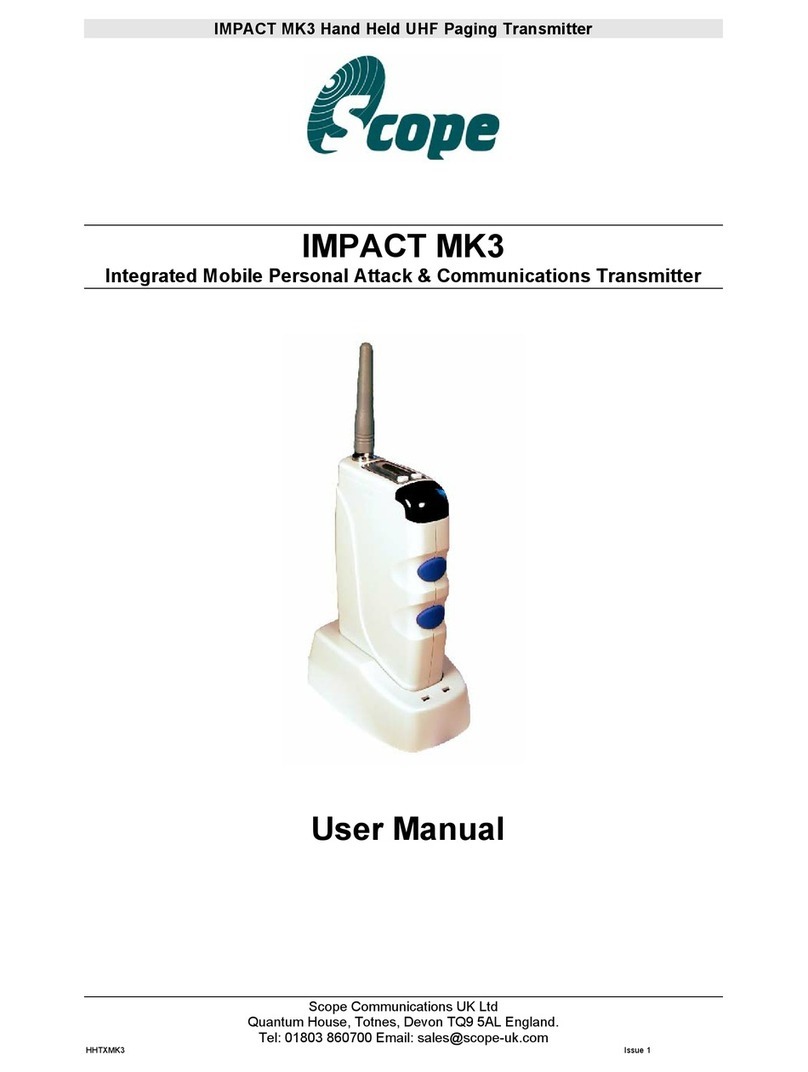
scope
scope Impact Mk3 user manual
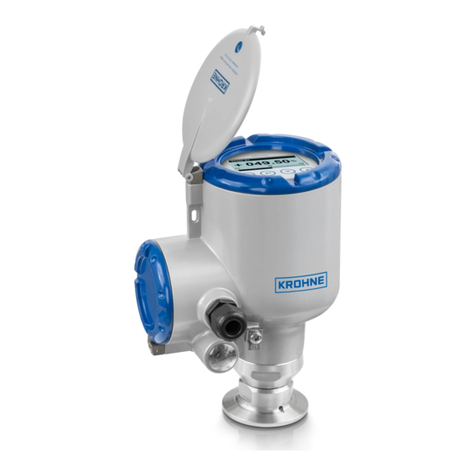
KROHNE
KROHNE OPTIWAVE 500 Series Supplementary instructions
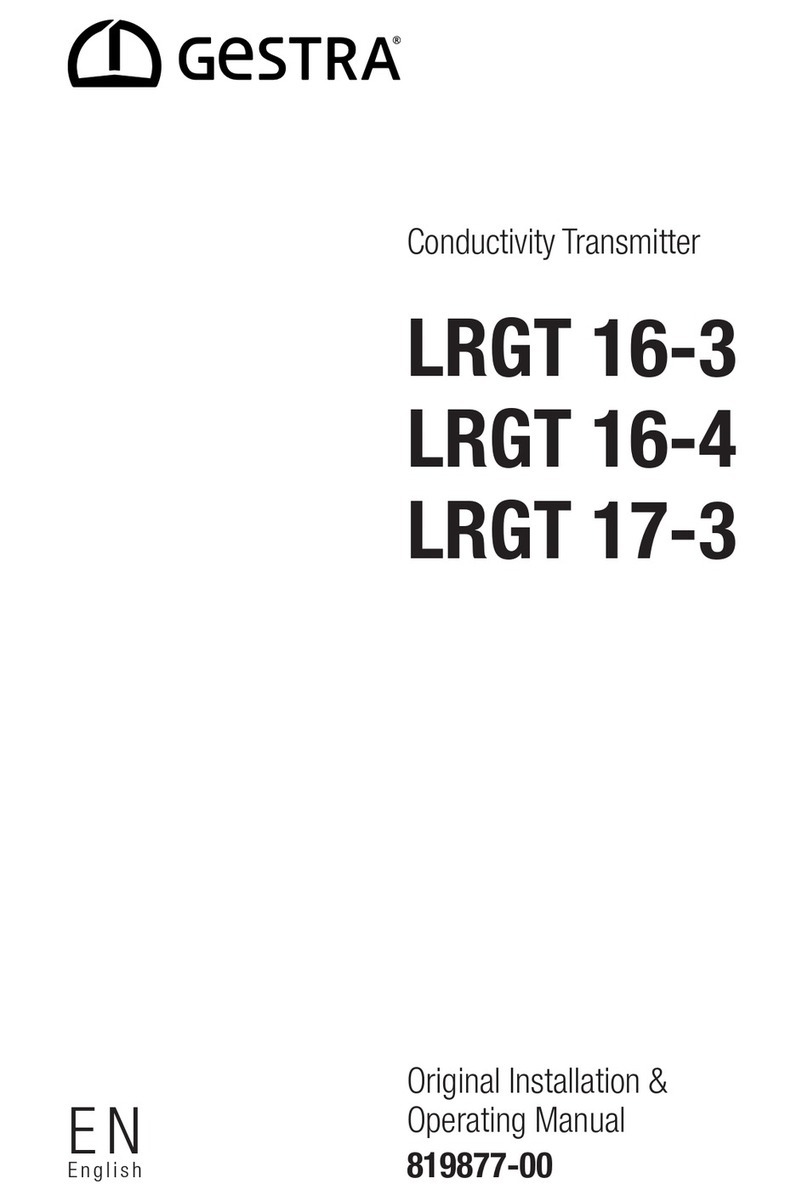
GESTRA
GESTRA LRGT 16-3 Installation & operating manual
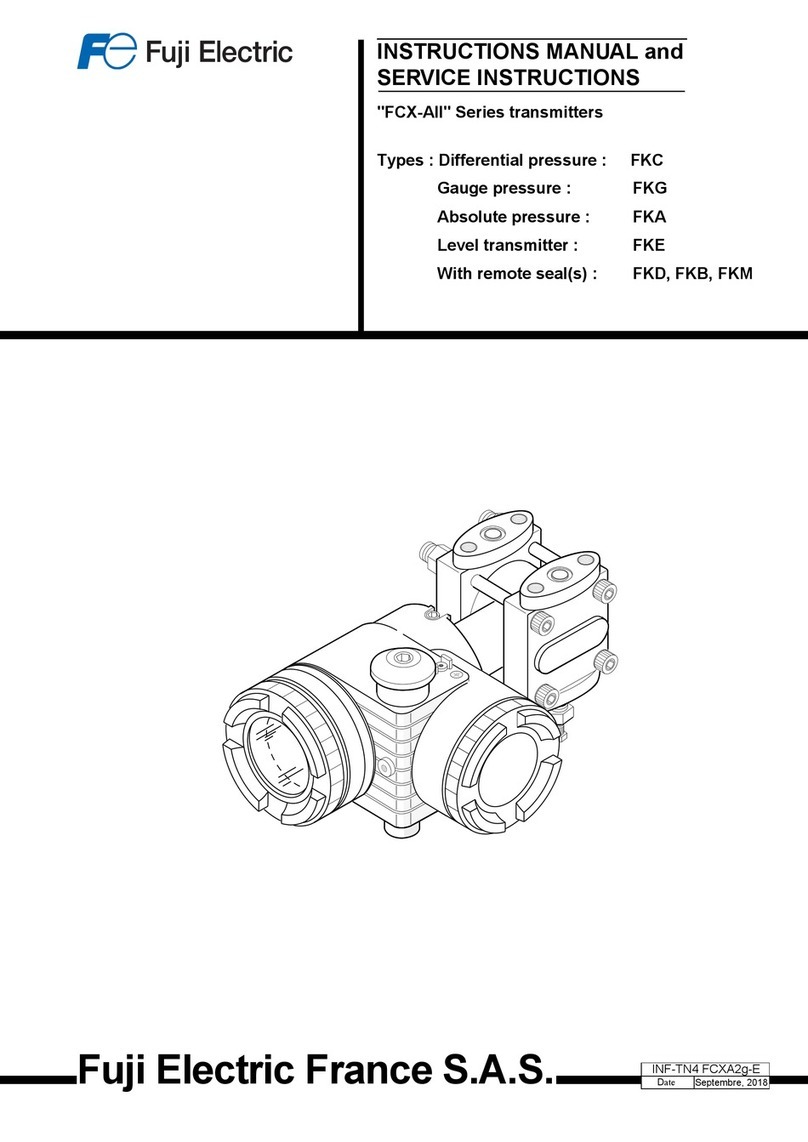
Fuji Electric
Fuji Electric FCX-AII Series INSTRUCTIONS MANUAL AND SERVICE INSTRUCTIONS
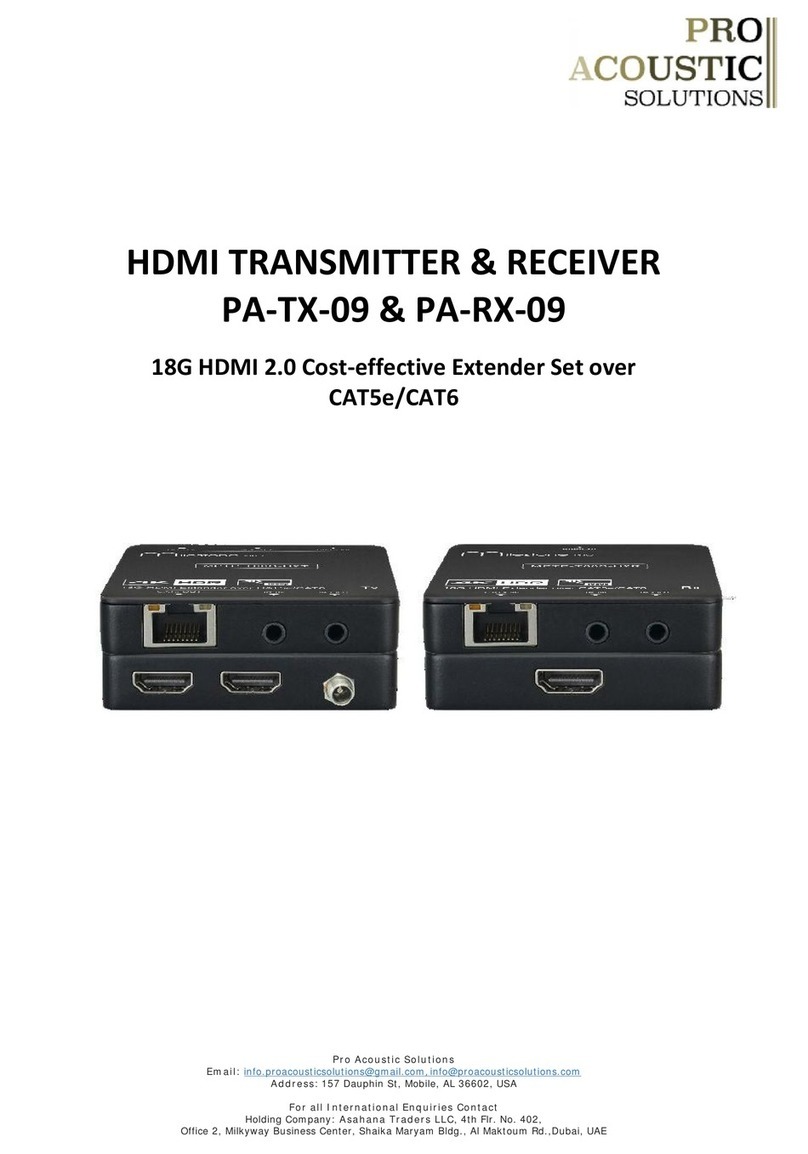
PRO ACOUSTIC SOLUTIONS
PRO ACOUSTIC SOLUTIONS PA-TX-09 user manual
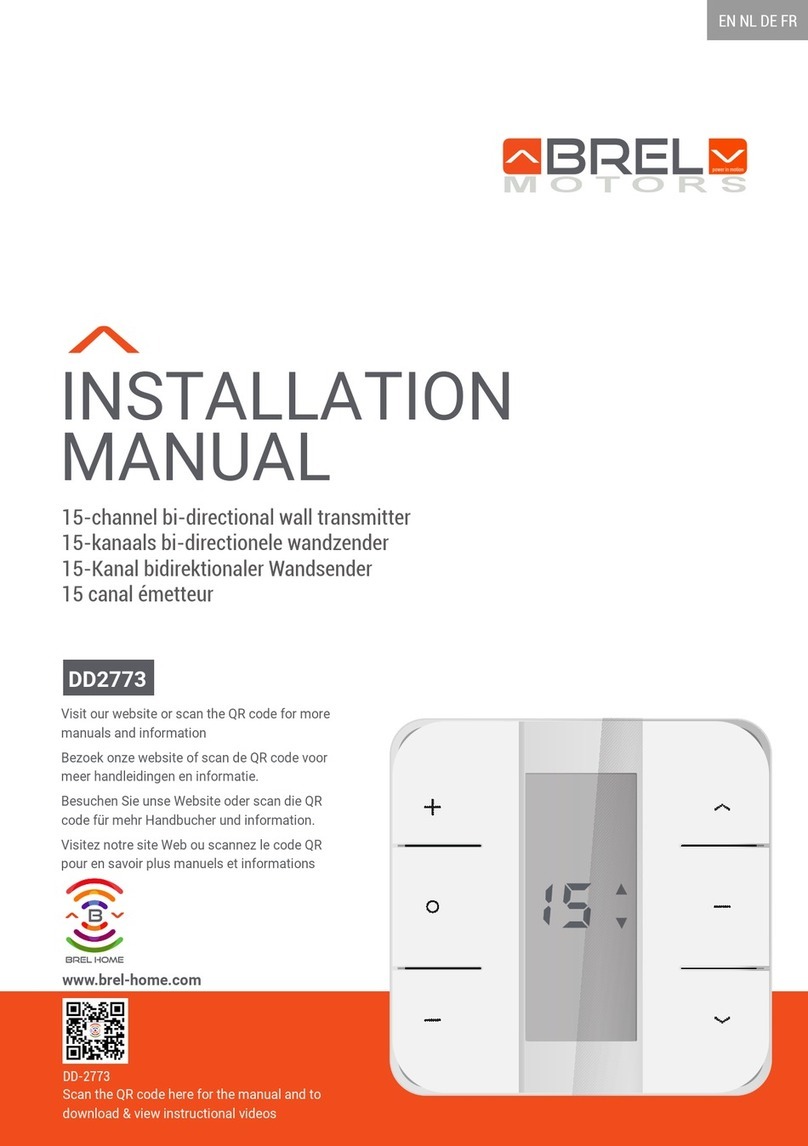
brel-motors
brel-motors DD2773 installation manual
